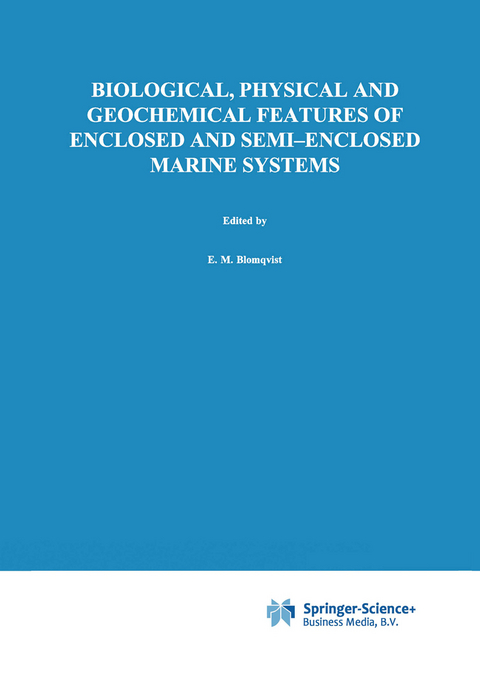
Biological, Physical and Geochemical Features of Enclosed and Semi-enclosed Marine Systems
Springer (Verlag)
978-0-7923-5784-1 (ISBN)
The book covers a wide range of topics in this field, including hydrography and modelling, eutrophication, environmental gradients, pelagic and benthic communities, introduced species and case studies of environmental impact.
This volume of 28 papers summarizes current knowledge on the broad-scale topics of enclosed and semi-enclosed marine systems, and should be of interest to scientists, students and administrators within the field of marine ecology, environmental impact control and conservation.
The influence of river runoff on deep water conditions in the Baltic Sea.- Water exchange as the main physical process in semi-enclosed marine systems: the Gulf of Riga case.- Modelling of dispersion processes in a tide-forced flow.- Interannual and regional variability of biological variables in a coupled 3-D model of the western Baltic.- Modelling regional and large-scale response of Baltic Sea ecosystems to nutrient load reductions.- An integrated biogeochemical model system for the Baltic Sea.- Phytoplankton and nutrient dynamics in the north-east Irish Sea.- Response to lowered nutrient discharges in the coastal waters around the island of Funen, Denmark.- Seasonal succession and growth in the plankton communities of the Gulf of Riga in relation to long-term nutrient dynamics.- Response of aquatic communities to anthropogenic stress: a comparative study of Neva Bay and the eastern Gulf of Finland.- Denitrification in estuarine sediments in the eastern Gulf of Finland, Baltic Sea.- Seasonal changes in sedimentary microbial communities of two eutrophic bays as estimated by biomarkers.- Sedimentation and particulate nutrient dynamics along a coastal gradient from a fjord-like bay to the open sea.- Phytoplankton and bacterioplankton production and bacterial biomass in a fjord-like bay — open sea gradient.- Heterotrophic nanoflagellates and bacteria in sediment of a brackish water sill basin in the Baltic Sea.- Identification of small-scale structure of plankton communities of the Black and Ionian Seas by their bioluminescence characteristics.- The benthic algal vegetation of land-locked fjords in southeastern Iceland.- Distribution of phytobenthos biomass in the Gulf of Riga (1984–1991).- Structure of phytobenthic and associated animal communities in the Gulf ofRiga.- Growth and production of three macrozoobenthic species in the Gulf of Riga, including comparisons with other areas.- A photographic study of the recolonization of cleared patches in a dense population of Mytilus edulis in the northern Baltic proper.- Structure of communities associated with dense assemblages of the tube-dwelling polychaete Polydora quadrilobata Jacobi (Spionidae) in the White Sea.- Distribution and seasonal dynamics of the Ponto-Caspian invader Cercopagis pengoi (Crustacea, Cladocera) in the Neva Estuary (Gulf of Finland).- Non-native animals in the Baltic Sea: alteration of benthic habitats in coastal inlets and lagoons.- Red tide of the dinoflagellate Heterocapsa triquetra (Dinophyta) in a ferry-mixed coastal inlet.- Littoral fish communities in the Archipelago Sea, SW Finland: a preliminary study of changes over 20 years.- Heavy metal uptake, physiological response and survival of the blue mussel (Mytilus edulis) from marine and brackish waters in relation to the induction of heat-shock protein 70.- Selection of southern Baltic banks — future marine protection areas.- Baltic Marine Biologists (BMB).- The Estuarine and Coastal Sciences Association (ECSA).
| Reihe/Serie | Developments in Hydrobiology ; 135 |
|---|---|
| Zusatzinfo | XIV, 280 p. |
| Verlagsort | Dordrecht |
| Sprache | englisch |
| Maße | 210 x 297 mm |
| Themenwelt | Naturwissenschaften ► Biologie ► Limnologie / Meeresbiologie |
| Naturwissenschaften ► Biologie ► Ökologie / Naturschutz | |
| ISBN-10 | 0-7923-5784-1 / 0792357841 |
| ISBN-13 | 978-0-7923-5784-1 / 9780792357841 |
| Zustand | Neuware |
| Haben Sie eine Frage zum Produkt? |
aus dem Bereich


